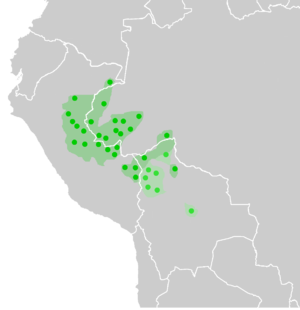| Pano-Tacanan | |
|---|---|
| (proposed) | |
| Geographic distribution | southern Amazon |
| Linguistic classification | Macro-Panoan ?
|
| Subdivisions | |
| Glottolog | pano1259 |
 Panoan languages (dark green) and Tacanan languages (clear green). Circles indicate locations of modern languages. | |
Pano-Tacanan (also Pano-Takana, Pano-Takánan, Pano-Tacana, Páno-Takána) is a proposed family of languages spoken in Peru, western Brazil, Bolivia and northern Paraguay. There are two close-knit branches, Panoan and Tacanan (Adelaar & Muysken 2004; Kaufman 1990, 1994), with 33 languages. There are lexical and grammatical similarities between the two branches, but it has not yet been demonstrated that these are genetic (Loos 1999).
Most Panoan languages are spoken in either Peru or western Brazil; a few are in Bolivia. All Tacanan languages are spoken in Bolivia (Ese’ejja is also spoken in Peru).
YouTube Encyclopedic
-
1/1Views:2 312
-
LANGUAGES OF THE WORLD 1. Genealogical Approach (English Version)
Transcription
Genealogical relations
Migliazza has presented lexical evidence in support of a genetic relationship between the Panoan and Yanomaman languages. He also suggests that a Panoan–Chibchan relationship is plausible.[1]
Jolkesky (2016) also notes that there are lexical similarities with the Arawakan languages due to contact.[2]
Comparison
Below is a list of lexical cognates shared between Proto-Pano and Proto-Takana, demonstrating the genetic relatedness of the Pano and Takana branches. The two branches also share many basic cognate grammatical morphemes.[3]
| gloss | proto-Pano | proto-Takana | proto-Pano-Takana |
|---|---|---|---|
| tree | *hiwi | *akwi | **hegwi |
| tooth | *ʂɨ- | *t͡ʂe- | **ʂɨ- |
| two | *ɾa-ßɨta | *beta | **bɨta |
| liver | *takwa | *takwa | **takwa |
| leaf | *pɨɁi | *pei ‘to fan’ | **pɨɁi |
| bone | *ʂao | *t͡ʂau | **ʂau |
| tongue | *hana | *ana | **hana |
| hand | *mɨ- | *me- | **mɨ- |
| night | *(ya)mɨtV | *meta | **mɨta |
| skin | *ßitsi | *biti | **bitsi |
| fire | *tsiɁi | *ti | **tsiɁi |
| knee | *ɾã- | *da | **da-n |
| blood | *himi | *ami | **hemi |
| breast | *ʂo- | *aṭṣu | **aṣu |
| sun | *ßari | *badi ‘moon’ | **badi |
| I | *Ɂɨ | *e | **Ɂɨ |
| you (sg.) | *mi | *mi | **mi |
| come | *ßɨ- ‘come, bring’ | *be- ‘bring’ | **bɨ- |
| flesh | *nami | *ɾami | **Nami |
| fat (n.) | *ʂɨni | *ṭṣeri | **ṣɨNi |
| fingernail | *mɨ̃-tsis[i] | *metiji | **mɨ-tsizi |
| foot, leg | *ta- ‘foot’ | *ta- ‘leg’ | **ta- |
| lip, edge | *kwɨ- | *kwe(i)- | **kwɨ ~ **kɨ- |
| cheek | *tamo | *tamu | **tamu |
| mouth | *kwɨʂa[CV] | *kwat͡ʂa | **kweʂa |
| elbow | *βaȿ(u)- | *–batʂu | **baṣu |
| howler monkey | *ɾoʔo | *duʔu | |
| mother | *ɨwa | *e-kwa | |
| big | *ani | *aɾi | |
| flute | *ɾɨwɨ | *dewe | |
| hole | *kini | *kani |
Bibliography
- Adelaar, Willem F. H.; & Muysken, Pieter C. (2004). The languages of the Andes. Cambridge language surveys. Cambridge University Press.
- Campbell, Lyle. (1997). American Indian languages: The historical linguistics of Native America. New York: Oxford University Press. ISBN 0-19-509427-1.
- Kaufman, Terrence. (1990). Language history in South America: What we know and how to know more. In D. L. Payne (Ed.), Amazonian linguistics: Studies in lowland South American languages (pp. 13–67). Austin: University of Texas Press. ISBN 0-292-70414-3.
- Kaufman, Terrence. (1994). "The native languages of South America." In C. Mosley & R. E. Asher (Eds.), Atlas of the world's languages (pp. 46–76). London: Routledge.
- Suárez, Jorge A. (1973). Macro-Pano-Tacanan. In International Journal of American Linguistics, Vol. 39, No. 3, pp. 137-154. The University of Chicago Press. Accessed from DiACL.
References
- ^ American Indian Languages, Oxford Studies in Anthropological Linguistics, Campbell, Lyle, 2000.
- ^ Jolkesky, Marcelo Pinho de Valhery (2016). Estudo arqueo-ecolinguístico das terras tropicais sul-americanas (Ph.D. dissertation) (2 ed.). Brasília: University of Brasília.
- ^ Valenzuela, Pilar; Zariquiey, Roberto (2023-02-16). "Language classification in Western Amazonia: Advances in favor of the Pano-Takana hypothesis". LIAMES: Línguas Indígenas Americanas. 23. Universidade Estadual de Campinas. doi:10.20396/liames.v23i00.8670150. ISSN 2177-7160.
External links
- Proel: Familia Pano-Tacanana
- Proel: Familia Panoana
- Proel: Familia Tacanana
